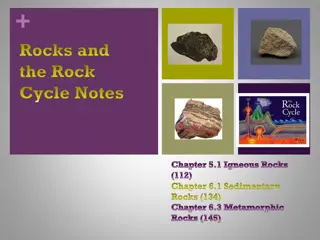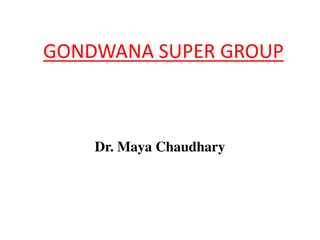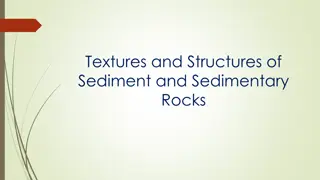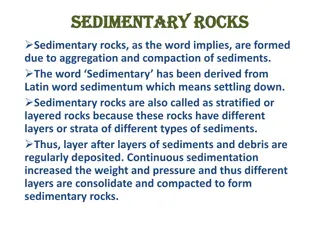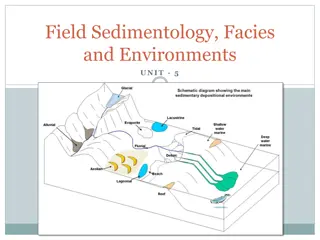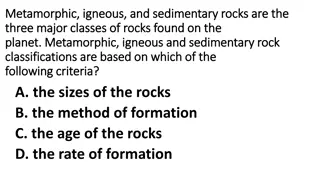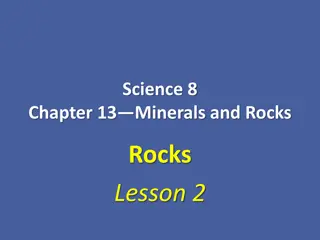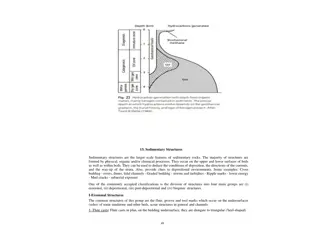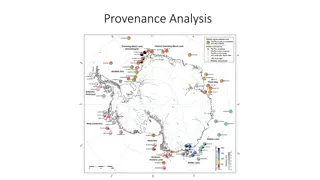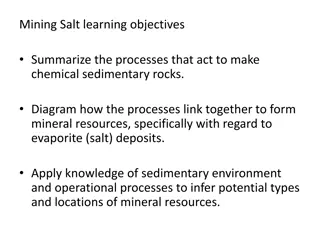Understanding Diagenesis and Lithification in Sedimentary Rocks
Diagenesis and lithification are crucial processes that transform loose sediment into solid rock through compaction and cementation. Diagenesis involves various chemical, physical, and biological changes while lithification involves the pressure-induced consolidation of sediment. Compaction removes excess water, while cementation binds sediment grains together using natural cements like calcite and silica. These processes are essential for the formation of sedimentary rocks.
Download Presentation

Please find below an Image/Link to download the presentation.
The content on the website is provided AS IS for your information and personal use only. It may not be sold, licensed, or shared on other websites without obtaining consent from the author. Download presentation by click this link. If you encounter any issues during the download, it is possible that the publisher has removed the file from their server.
E N D
Presentation Transcript
Diagenesis Diagenesis is used to describe all the chemical, physical, and biological changes, including cementation, undergone by a sediment after its initial deposition, exclusive of surface weathering. Some of these processes cause the sediment to consolidate: a compact, solid substance forms out of loose material. As sediment deposition builds up, the overburden (or lithostatic) pressure rises, and a process known as lithification takes place. Sedimentary rocks are often saturated with seawater or groundwater, in which minerals can dissolve or from which minerals can precipitate. Precipitating minerals reduce the pore space in a rock, a process called cementation. Due to the decrease in pore space, the original connate fluids are expelled. The precipitated minerals form a cement and make the rock more compact and competent. In this way, loose clasts in a sedimentary rock can become "glued" together.
Turning sediment into rock Diagenesis includes: Recrystallization growth of stable minerals from less stable ones. Lithification loose sediment is transformed into solid rock by compaction and cementation. Compaction: As more sediments are piled on top, compaction drives out the excess water. Cementation: Precipitation of chemicals dissolved in water binds grains of a sediment together. Natural cements: calcite, silica, and iron oxide. Formed from ions in solution in water.
Compaction 1.Where sediments are deposited, layer upon layer builds up. Pressure from the upper layers pushes down on the lower layers. 2. If the sediments are small, they can stick together and form solid rock. This process is called compaction.
Cementation 1. Large sediments, like sand and pebbles, cannot form rock from pressure alone. Large sediments have to be cemented together. 2. As water moves through soil and rock, it picks up materials released from minerals during weathering. 3.The resulting solution of water and dissolved materials moves through open spaces between sediments.
Cementation 4. Cementation occurs when minerals such as quartz, calcite, and hematite are deposited between the pieces of sediment. 5. These minerals, acting as natural cements, hold the sediment together like glue, forming a detrital sedimentary rock.
Cementation: Cementing material is usually secondary Silica (Siliceous cement), (Carbonate cement), Iron rich (ferruginous cement) Calcium carbonate Cement itself to some extent is the source of weakness in the sedimentary rocks Because cementing material and the clastic sediments are usually composition, leading to heterogeneity in their physical characteristics. of different
Hence such rock will not behave homogeneously under stress, resulting into development of cracks or fissures which develops in cementing material. If the cement is Calcium Carbonate- it is undesirable, because it is susceptible to dissolve in Carbon-dioxide in water However, if cementation process continuous for longer span of time cementation will become more complete, which reduce the porosity and permeability in the rock mass and increase competence. Shape of grains: i.e. if coarser grains, rounded or sub-rounded are cemented material, will not have firm grip=such rocks behave as incompetent rocks.
Authigenesis Authigenesis is the process whereby a mineral or sedimentary rock deposit is generated where it is found or observed. Such deposits are described as authigenic. Authigenic sedimentary minerals form during sedimentation by precipitation or recrystallization instead of being transported from elsewhere (allogenic) by water or wind. Authigenic sediments are the main constituents of deep sea sedimentation. Authigenic clays tend to reduce reducing permeability. In metamorphic petrology an authigenic mineral is one formed situ during metamorphism, again by precipitation from fluids or recrystallization. the porosity of sediments, thus in For any mineral to be precipitated, the water must be oversaturated with respect to that mineral. For the carbonate compensation depth, or that the pore waters are sufficiently saturated due to dissolution of other grains that precipitation can begin. The alkalinity can also be reduced by microbial sulphate reduction. calcite, this means that the area of deposition must be above
Common Authigenic Minerals in Sedimentary Rocks Calcium carbonate Apatite Clays Hematite Limonite Chamosite Siderite Silica Glauconite Pyrite
Neomorphism Neomorphism refers to the wet metamorphic process in which diagenetic alterations systematically transform minerals into either polymorphs or crystalline structures that are structurally identical to the rock(s) from which they developed. Neomorphism encompasses the functions of both recrystallization and inversion, which are geological processes that deal primarily with rock reformation. The neomorphic process, as it relates to geology and petrography, is one of the many major processes that sustain both carbonate minerals and limestone. Neomorphism is largely held accountable for the metastability of aragonite and magnesium-rich calcite, and when conditions permit, neomorphic reactions and interactions can result in texture loss and/or feature deformation of affected rock formations.
Types of Neomorphism Recrystallization The term "recrystallization" broadly refers to the many metamorphic processes that change the size and/or shape of crystal formations and preserve the chemical composition and mineralogy of the original mineral. Since recrystallization accounts for the majority of all visible changes produced by "neomorphism" and "recrystallization" implicitly allude to each other and can therefore be used interchangeably under most circumstances. In petrology, there are two forms of recrystallization: recrystallization by inversion by replacement. neomorphism, the terms and recrystallization
Replacement Replacement is a complex form of neomorphism in which the recrystallization process involves the dissolution of one mineral and the immediate "precipitation" of another in its place. The resultant mineral differs from its predecessor in terms of its chemical composition. Replacement occurs without any substantial changes in volume between the original and the reformed mineral. The process is often characterized as being either fabric-destructive or fabric- preserving, which refer to texture loss and texture retention, respectively. The replacement of fossils with chert, for example, is often fabric-preserving, while the replacement of aragonite and calcite with dolomite is fabric-destructive. On a side note, this particular process (the replacement of aragonite and calcite with dolomite) is the most common form of recrystallization by replacement. Recrystallization by replacement occurs on a variety of minerals, including chert, pyrite, hematite, apatite, anhydrite, and dolomite, among others.
Inversion Inversion is a complex form of neomorphism in which the recrystallization process transforms polymorphs into different polymorphs. Polymorphs, are minerals that differ from one another in their crystalline structures but are otherwise composed of identical quantities and types of elements. As with any change in mineral structure, the alteration of polymorphs occurs most often in environments characterized by certain optimal temperatures and pressure levels. Optimal temperature and pressure levels vary in accordance to the type of mineral(s) under consideration. Specifically, an increase in temperature incites an increase in atomic vibrations, which instigates atoms to distance themselves from each other. The excited atoms continue expanding until the increase in temperature can no longer provide the energy necessary for further expansion. Affected crystals and/or minerals are forced to adapt to the aforementioned atomic changes by expanding their skeletal structures, which results in visible changes of the aforementioned crystals and minerals.
Inversion (Cont) All the while, pressure continuously compresses the altered crystals and minerals into dense structures; the final product is a collection of chemically-identical crystals that differs structurally and visibly from its predecessor. Perhaps the most pervasive example of inversion occurs on carbon. The inversion of carbon, depending on the temperature and pressure of the environment, results in one of two very distinct polymorphs: Under low temperature and low pressure, recrystallization by inversion will result in coal, and under high pressure and high temperature, recrystallization by inversion will result in diamond. Both coal and diamond are derived from carbon and are chemically identical, but they differ remarkably from each other in terms of physical appearance.


